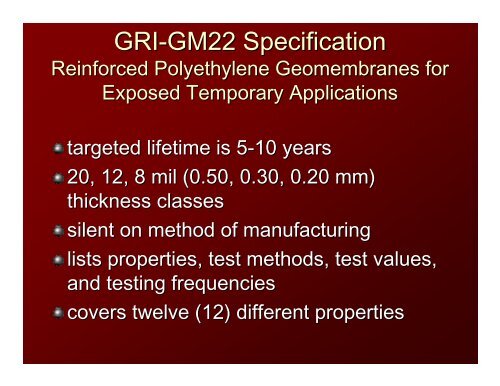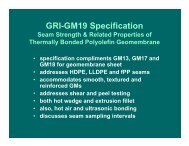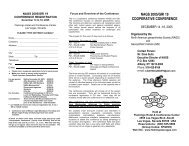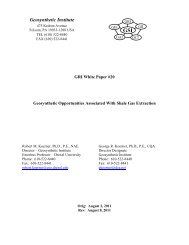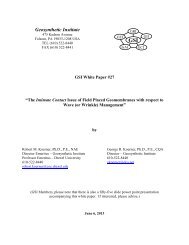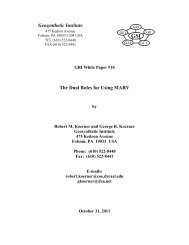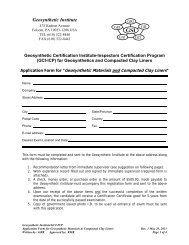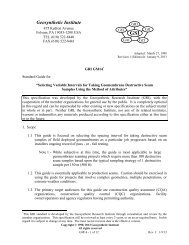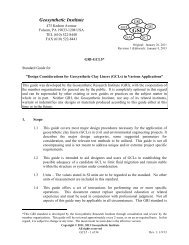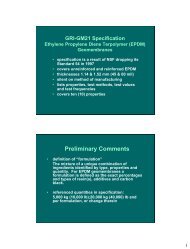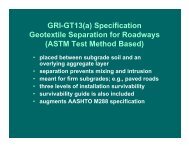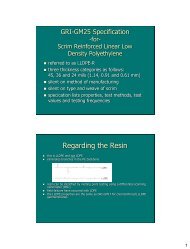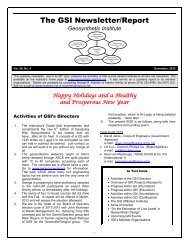Power Point Tutorial - The Geosynthetic Institute
Power Point Tutorial - The Geosynthetic Institute
Power Point Tutorial - The Geosynthetic Institute
Create successful ePaper yourself
Turn your PDF publications into a flip-book with our unique Google optimized e-Paper software.
GRI-GM22 GM22 Specification<br />
Reinforced Polyethylene Geomembranes for<br />
Exposed Temporary Applications<br />
targeted lifetime is 5-105<br />
years<br />
20, 12, 8 mil (0.50, 0.30, 0.20 mm)<br />
thickness classes<br />
silent on method of manufacturing<br />
lists properties, test methods, test values,<br />
and testing frequencies<br />
covers twelve (12) different properties
Strength Categories<br />
qualitative categories<br />
1. severe; 20 mil (0.45 mm)<br />
2. moderate; 12 mil (0.30 mm)<br />
3. gentle; 8 mil (0.20 mm)<br />
categories refer to the following:<br />
1. type of subgrade<br />
2. manner of installation<br />
3. anchorage and tie downs<br />
4. site-specific specific conditions
Preliminary Comments<br />
definition of “formulation”<br />
<strong>The</strong> mixture of a unique combination of<br />
ingredients identified by type, properties<br />
and quantity. For PE geomembranes a<br />
formulation is defined as the exact<br />
percentages and types of resin(s), additives<br />
and carbon black.<br />
values based on U.S. (English) units<br />
conversion to S.I. units is “soft”
Physical Properties<br />
1. thickness<br />
Mechanical Properties<br />
3. grab strength<br />
4. grab elongation<br />
7. tongue tear<br />
9. hydrostatic resistance<br />
Endurance Properties<br />
11. OIT<br />
2. weight<br />
5. strip strength<br />
6. strip elongation<br />
8. CBR puncture<br />
10. WVT<br />
12. UV Resistance
1. Thickness<br />
follows ASTM D751<br />
dead weight micrometer with flat tip<br />
includes scrim when reinforced<br />
10-specimens across roll width<br />
required for each roll<br />
average must equal nominal<br />
lowest individual is –10%
D751<br />
Thickness Test
2. Weight<br />
correct term is mass per unit area<br />
follows ASTM D751<br />
five specimens across roll width<br />
values averaged and compared to spec<br />
value stated as “min. ave.”<br />
straightforward test on every roll<br />
unit is lb/1000 ft 2 (kg/1000 m 2 )
ASTM D751<br />
“Weight”
3/4 & 5/6. Grab and Strip Tensile<br />
Strength<br />
ASTM D7004; grab strength & elongation<br />
ASTM D7003; strip strength & elongation<br />
both tests are required<br />
min. ave. . of both 5 MD and 5 XMD<br />
every 20,000 lb (9000 kg)
ASTM D7004 – Grab Tensile Test (Measures Strength and Elongation)
ASTM D7003 – Strip Tensile Test<br />
(Measures Strength and Elongation)
7. Tongue Tear Test<br />
uses ASTM D5884<br />
specimen 8 × 4 × 3 in.<br />
(200 × 100 × 75 mm slit)<br />
speed is 2.0 in./min (50 mm/min)<br />
average of 5MD and 5XMD<br />
every 20,000 lb (9,000 kg)
D5884<br />
Tongue Tear
8. CBR Puncture Strength<br />
California Bearing Ratio (CBR) is a soil<br />
strength test adopted for geosynthetics<br />
puncture<br />
follows ASTM D6241 using the same device<br />
probe is 2.0 in. (50 mm) diameter<br />
container is 6.0 in. (150 mm) diameter<br />
10 specimens across roll width<br />
take average value of each<br />
every 20,000 lb (9,000 kg)
D6241 - Puncture (CBR) Strength<br />
(Evaluates Strength at Rupture and Accompanying Deformation)
9. Hydrostatic Resistance<br />
follows ASTM D751<br />
specimen inflated with water<br />
inflated diameter 1.24 in. (31 mm)<br />
pressure rate 6.0 in 3 .min (1.6 cm 3 /sec)<br />
every 45,000 lb (20,000 kg)
ASTM D751 – Hydrostatic Resistance Testing
10. Water Vapor Transmission<br />
(WVT)<br />
follows ASTM E96<br />
GM covers an aluminum cup<br />
encloses water or desiccant at 73°F F (23°C)<br />
and 50% RH<br />
placed in relative humidity chamber<br />
looses weight (water) or gains (desiccant)<br />
slope of weight vs. time graph is WVT<br />
max. values are 0.4, 0.7, 1.2 g/m 2 -day
ASTM E96 – Water Vapor Transmission Test
11. Oxidative Induction Time<br />
OIT is an indirect measure of the amount of<br />
antioxidants in the formulation<br />
HP-OIT, per ASTM D5885, is required<br />
small specimen ~ 2 mg<br />
pressure at 500 lb/in. 2 (3500 kPa)<br />
temperature at 150°C C in N 2 ; 1-min. 1<br />
dwell; switch<br />
to 0 2 ; record time; see following<br />
requires 1000 min. for as manufactured material
HP-OIT (ASTM D5885)
D5885<br />
HP-OIT
12. Ultraviolet Resistance<br />
assessment of UV stability of the AOs and CB (there<br />
should be synergy between them)<br />
uses a QUV laboratory weatherometer<br />
follows ASTM D7238<br />
called “ultraviolet fluorescent device”<br />
20 hr. UV cycle at 75°C, then 4 hr. condensation at<br />
60°C C for 10,000 hr.<br />
≥ 50% grab strength and elongation to be retained<br />
also, no cracking after incubation per GRI GM16<br />
frequency is once per formulation
ASTM D7238 – Ultraviolet Fluorescent Weatherometer
In Addition to the OIT Criterion<br />
incubated specimen cannot crack<br />
follows GRI GM16 test method<br />
180 deg. bending within a holder<br />
visual observation for cracks at 7X<br />
magnification resulting in a “go” or<br />
“no-go” decision
Test Specimen as Removed from Weathering Device, Bent 180 deg.<br />
and Clamped Between Two Wooden Blocks and One of the C-ClampC<br />
Clamp
Concluding Comments<br />
specification addresses reinforced<br />
polyethylene GMs for exposed installations<br />
this is MQC specification i.e., lists the<br />
manufacturers required tests, minimum<br />
values and frequencies<br />
if MQA project specific spec is more<br />
restrictive, manufacturer may ask for<br />
additional compensation
<strong>The</strong> Basic Tables Follow<br />
PE-R – English Units<br />
PE-R – SI Units<br />
Note: <strong>The</strong> most recent version of this specification<br />
(text and tables) is available on the GSI Web<br />
Site at .


